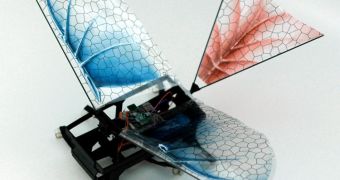Learning more about how each species or group of species evolved over time is a daunting task, especially considering that the fossil record is incomplete. But some time robots can shed light on history, as was recently the case with a robotic bug that got a set of wings.
As soon as experts outfitted the tiny bug with its new accessories, they began to notice aspects of its flight that could be indicative of the way the first bird species looked and behaved like while learning to fly. In other words, the team shed more light on the origins of flight.
According to University of California in Berkeley (UCB) engineers, it would seem that the hypothesis holding that the first birds originated in creatures that glided down from trees is correct after all.
After the Dynamic Autonomous Sprawled Hexapod (DASH) robot – a 10-centimeter, or 4-inch device – got its wings, the researchers noticed that the machine displayed significantly improved running performances, something that could not be achieved otherwise.
Still, the extra boost was not sufficient to generate enough speed to enable the critter to launch from the ground. What this could imply is that indeed gliding species were the first source of modern flight.
The UCB research team was led by the head of the UCB Biomimetic Millisystems Lab, Ron Fearing. The expert also holds an appointment as a professor of electrical engineering at the university. The study appears in the October 18 online issue of the scientific journal Bioinspiration and Biomimetics.
“Our overall goal is to give our robots the same all-terrain capabilities that other animals have. In the real world, there will be situations where flying is a better option than crawling, and other places where flying won’t work, such as in confined or crowded spaces,” he explains.
“We needed a hybrid running-and-flying robot,” the investigator adds. This is why the UCB team first began work on DASH, a couple of years ago. The experts managed to increase the robot's speed by 200 percent by simply adding the wings.
Its speed increased from 0.68 meters per second with legs alone to 1.29 meters per second (2.23 to 4.2 feet). DASH also became able to run up slopes angled at 16.9 degrees, as opposed to 5.6 degrees.
“With wings, we saw improvements in performance almost immediately,” explains Fearing lab PhD student Kevin Peterson, who was also the lead author of the new study.
“Not only did the wings make the robot faster and better at steeper inclines, it could now keep itself upright when descending. The wingless version of DASH could survive falls from eight stories tall, but it would sometimes land upside down, and where it landed was partly guided by luck,” he concludes.

 14 DAY TRIAL //
14 DAY TRIAL //